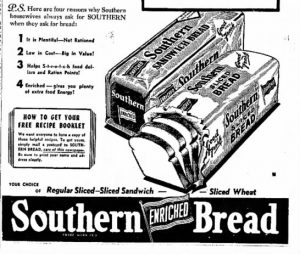In this advertisement from The Daily Times in 1943, housewives were encouraged to purchase enriched bread for their families to aid the war effort. This bread, along with other baked goods and products on the market were made with new enriched flour. This new kind of flour was developed in laboratories around the country and was enriched with vitamins and minerals not usually found in wheat flour that allowed for the bread itself to function almost like a supplement for any nutrition that might be lacking in diets affected by rationing. This technology was initially developed for military use to make soldiers diets simultaneously both more simple and more nutritious, ensuring that the diets of the men supporting our country were not lacking any essential nutrients. Later, the technology was also implemented into uses at home in the States as diets were altered due to the changes in food supply.

Bread Advertisement from 1943
Southern Enriched Bread was also inexpensive, despite the new technology involved with its ingredients, adding to its popularity and accessibility during a time that rations limited families abilities to purchase foods. Along with being inexpensive, this bread was also more convenient than homemade bread. While sliced bread had been sold commercially for about fifteen years, the number of men being enlisted in the military resulted in a higher number of women in the workforce, leaving them with less time to spend in the kitchen preparing meals for their families.
This advertisement is for more than just the bread, it is also an advertisement for a recipe booklet, Breadwinners, sponsored by the company selling the bread in the advertisement, Southern Enriched Bread. These mail order recipe booklets were extremely common during the 1940s because they helped women understand how to cook with more of the preserved and processed foods on the market. The recipes were also designed to use ingredients with the least number of ration points, saving families money and ration stamps. The companies would offer these books for free and use their products in the recipes, giving their otherwise unfamiliar products a place in the diets of families. Not only did this aid the company selling the products, but it also aided the families who could save money and ration points by purchasing these goods, and it helped the war effort by organizing the distribution of foods and normalizing enriched foods.
Link to larger Image: Here
Southern Enriched Bread. “How to Get Your Free Recipe Booklet.” The Daily Times, Burlington NC, 4 June 1943, p. 5.
Latson, Jennifer. “Sliced Bread: The History of How It Became ‘The Best Thing’.” Time, Time, 7 July 2015, time.com/3946461/sliced-bread-history/.
Wartime and Post-war Foodways 1940-1959
Abigail Bowdish